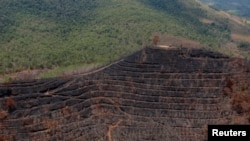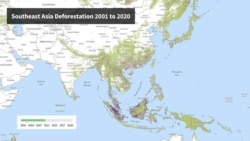New research has found that the tropical forests in the mountains of Southeast Asia are losing trees at an accelerated rate, deepening a wide range of ecological concerns.
Southeast Asia is home to about 15% of the world’s tropical forests and help sustain plant and animal biodiversity. The trees also store carbon, keeping it out of the atmosphere where it would further contribute to warming global temperatures.
But clearing the forests of trees has reduced the ecosystem’s capacity for carbon storage, according to a study recently published in Nature Sustainability.
In many parts of the world, people have cleared out forests to make space for subsistence agriculture and cash crops. In Southeast Asia, illegal logging is also responsible for a huge amount of deforestation. As forests shrink, their ability to counteract human carbon emissions dwindles.
“We know there is substantial deforestation on mountains [in Southeast Asia], but we didn’t know if it was increasing and how it affected carbon,” said Zhenzhong Zeng, an earth system scientist at Southern University of Science and Technology in China and a co-author of the study. “Now, we find that it’s increasing.”
The researchers used satellite images to track forest loss over time and carbon density maps to calculate corresponding reductions in carbon storage capacity.
Their results showed that Southeast Asia has lost 61 million hectares of forest over the last 20 years. In the 2000s, the annual loss was about an average of 2 million hectares a year. Between 2010 to 2019, that number doubled to about 4 million hectares a year.
“I think what’s surprising is just the rate that it’s occurring at, and not the fact that it is occurring,” said Alan Ziegler, a physical geographer at Mae Jo University in Thailand and another co-author of the study.
About a third of trees cleared were in mountainous regions such as northern Laos, northeastern Myanmar and the Indonesian islands Sumatra and Kalimantan, the study found.
Experts previously thought that these trees, protected by rugged mountain landscape, would be less affected by human intervention compared to trees found in flatter lowlands. But the study found that with cultivatable lowlands growing more limited, forest clearance has expanded into the mountains. In 2001, mountain trees made up about 24% of all trees cleared that year. By 2019, it was over 40%.
“I think it’s innovative, the way they look at how [forest loss] shifts from lowland areas to the mountain areas,” said Nophea Sasaki, who studies forest carbon monitoring at Asian Institute of Technology in Thailand and was not involved in the study. “I think that’s a great concern.”
Forests at higher elevation and on steeper slopes tend to store more carbon than lowland forests, according to the study. If people are clearing out more mountain trees, then the forests could lose even more carbon than current climate change models predict.
If land is set aside, trees can regrow and restore their carbon stocks. But the natural habitats forests support and the great biodiversity they contain may be lost forever. Species unique to the region could disappear. The forests’ protection of watersheds and flood prevention capacity may also vanish.
“It’s not only about carbon. In terms of environmental destruction on a long-term basis, it would destroy nature. It would destroy all biodiversity,” Sasaki said.
Complicating the picture is inconsistent monitoring and enforcement of forest protection between countries and states. Experts say advances in technology, such as the satellite data used in this study, and public attention on the issue will be important for closer monitoring and prevention of forest loss.
“We should be obligated to protect the forest because without these forests, we cannot survive,” Sasaki said.








